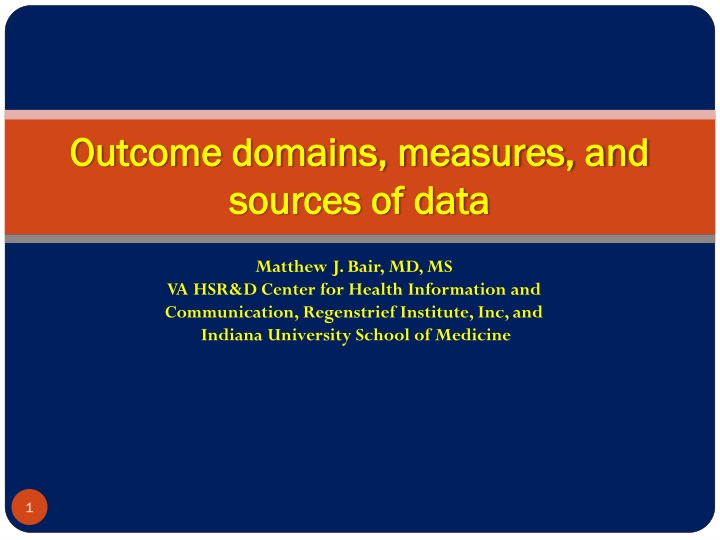Outcome Domains, Measures & Data Sources in Clinical Trials
Precis-2 tool and the pragmatic-explanatory continuum indicator provide a framework for designing clinical trials on a continuum from ideal to usual care conditions. Experience with Precis-2 tool helped in organizing discussions, determining consensus among study investigators, and refining study designs based on initial, ideal, and final perceptions.
Download Presentation

Please find below an Image/Link to download the presentation.
The content on the website is provided AS IS for your information and personal use only. It may not be sold, licensed, or shared on other websites without obtaining consent from the author.If you encounter any issues during the download, it is possible that the publisher has removed the file from their server.
You are allowed to download the files provided on this website for personal or commercial use, subject to the condition that they are used lawfully. All files are the property of their respective owners.
The content on the website is provided AS IS for your information and personal use only. It may not be sold, licensed, or shared on other websites without obtaining consent from the author.
E N D
Presentation Transcript
Outcome domains, measures, and Outcome domains, measures, and sources of data sources of data Matthew J. Bair, MD, MS VA HSR&D Center for Health Information and Communication, Regenstrief Institute, Inc, and Indiana University School of Medicine 1
Outline Outline PRECIS-2 tool Outcome domains Measures Data considerations 2
PRECIS-2 tool PRECIS (2009) original tool with 10 domains to design clinical trials on a continuum (Thorpe et al. J Clin Epi 2009) Explanatory attitude (ideal situation) to more pragmatic attitude (usual care) PRECIS-2 a validated, improved version of the tool 4
PRECIS-2 tool PRECIS-2 has 9 domains Each domain scored on a 5-point Likert continuum (from 1=very explanatory ideal conditions to 5=very pragmatic usual care conditions ) Trialists can more easily consider whether design decisions match their intended purpose 5
The Pragmatic-Explanatory Continuum Indicator Summary 2 (PRECIS-2) wheel 6
E Experience with PRECIS xperience with PRECIS We used PRECIS to: Organize discussion regarding study design of a planned trial Determine the extent of consensus among the study investigators Study Design and Setting Descriptive; Investigators meeting at VCU Read and reviewed the PRECIS criteria Team made judgments of the planned study regarding each PRECIS criteria to reflect initial, ideal and final study design perceptions.
E Experience with PRECIS xperience with PRECIS Results: Final study design was more explanatory than the preliminary plan Consensus achieved Conclusions and findings: Applying PRECIS principles were useful for (1) detailing points of discussion related to trial design, (2) making revisions to the design to be consistent with the project goals and (3) achieving consensus. May prove valuable for trial researchers Riddle et al. J Clinical Epidemiology 2010
Primary trial outcome Primary trial outcome Explanatory Pragmatic Direct consequence of intervention More disease-oriented Underlying mechanism Objectively measured Clinically meaningful More patient-important
Pragmatic outcomes & follow Pragmatic outcomes & follow- -up up Outcomes are long-term for trials of chronic pain conditions Clinically meaningful to study participants Follow-up is low-intensity Outcomes from existing data without patient contact
Selecting pain outcomes Selecting pain outcomes Pain trial general considerations Subjective/patient-reported outcomes Multiple important outcome domains General considerations Responsiveness Respondent burden Integration in clinical workflow
Key outcome domains Key outcome domains Pain intensity Pain interference Physical function Pain-related change 13
IMMPACT guideline for pain trials IMMPACT guideline for pain trials Pain, physical function, emotional function Condition-specific or generic pain measures General health-related QOL measures Adverse effects & symptoms, participant disposition http://www.immpact.org/publications.html Turk DC et al. Pain 2003;106: 337 345
Patient relevant pain outcomes Patient relevant pain outcomes Importance (0-10 scale) Fatigue Enjoyment of life Emotional well being Physical activity Weakness Staying asleep at night Difficulty concentrating 0 1 2 3 4 5 6 7 8 9 10 Turk DC et al. Pain 2008;137:276 285
Other relevant outcome domains Other relevant outcome domains Depression Anxiety Sleep 16
Other relevant outcome domains Other relevant outcome domains Work disability Medication/health care use Health-related quality of life well-being Other domains Catastrophizing Self-efficacy Pain coping 17
Measures Measures pain intensity pain intensity Numeric rating scale (NRS) Brief Pain Inventory intensity subscale Multidimensional Pain Inventory (MPI) 18
Measures pain interference Patient-Reported Outcomes Measurement Information System (PROMIS) BPI pain interference subscale (7) PEG Multidimensional Pain Inventory (MPI) Graded Chronic Pain Scale 19
Measures Measures physical function physical function PROMIS Physical Function 4-item 21
Measures Measures physical function physical function Roland Morris Disability Questionnaire Oswestry Disability Index Medical Outcomes Study SF-36 Bodily Pain Subscale Western Ontario McMasters Osteoarthritis Index 22
Measures Measures pain Patient-reported Global Impression of Change (PGIC) pain- -related change related change Since the start of the study (treatment), my overall pain is . 1. Much better 2. Moderately better 3. A little better 4. No change 5. A little worse 6. Moderately worse 7. Much worse 23
Measures Measures depression PROMIS depression Patient Health Questionnaire-9 (PHQ-9) PHQ-2 Beck Depression Inventory (BDI) Profile of Mood States (POMS) Hospital Anxiety and Depression Scale (HADS) 24
Measures Measures anxiety anxiety Generalized anxiety disorder-7 (GAD-7) GAD-2 Hospital Anxiety and Depression Scale (HADS) 25
PHQ PHQ- -2 and GAD 2 and GAD- -2 2 Over the last 2 weeks, how often have you been bothered by any of the following problems? Not at all Several days More than half the days Nearly every day Use a check ( ) to indicate your answer for each item (0) (1) (2) (3) 1. Feeling nervous anxiety or on edge 2. Not being able to stop or control worrying 3. Little interest or pleasure in doing things 4. Feeling down, depressed, or hopeless 26
Measures Measures sleep PROMIS Sleep 4-item sleep 27
CONSORT extension: pragmatic trials CONSORT extension: pragmatic trials Recommended extending 8 checklist items for reporting pragmatic trials 1. The background 2. Participants 3. Interventions 4. Outcomes 5. Sample size 6. Blinding 7. Participant flow 8. Generalizability of findings Zwarenstein et al. BMJ 2008
Checklist of items for reporting pragmatic Checklist of items for reporting pragmatic trials trials Standard CONSORT description Extension for pragmatic trials Section Item Explain why the chosen outcomes and, when relevant, the length of follow-up are considered important to those who will use the results of the trial Clearly defined primary and secondary outcome measures and, when applicable, any methods used to enhance the quality of measurements (eg, multiple observations, training of assessors) Outcomes 6 30
Data considerations Data considerations Quality and completeness of clinical data for research Availability of data Gaps in the data missing Consistency of measurement Heterogeneity of data across EHR/health systems 31
Data considerations Data considerations Origin of the data Why and how the data were collected Information on reliability and meaningful use for research 32
Data considerations Data considerations Important in the early planning stages of a trial Feasibility Can data collection be repurposed for research 33
Data sources Data sources Patient-reported outcomes Patient-generated data Clinical data Administrative or claims data Registry data 34
Selecting data sources Selecting data sources Is data source suitable to answer specific trial questions? A single source may not be sufficient Hybrid data sources? Use of multiple sources requires more planning, expense 35
Data quality and completeness Data quality and completeness Embedded electronic data capture (EDC) in electronic health record (EHR) Brief electronic case report forms (CRFs) automatically collected 36
Potential benefits Potential benefits May improve costs/efficiency May reduce patient and provider burden Greater degree of pragmatism 37
Potential challenges Potential challenges Require early strategic agreements w/ sites and health care systems Different EHR platforms Interruption of clinical workflow Security risks of EDC platforms 38
Best practices for data Best practices for data quality Begin with minimal set of core data elements quality Answer primary/secondary questions Plan how additional data elements affect clinical workflow 39
Best practices for data Best practices for data quality Integrate EDCs into clinical workflows quality Manage security risks 40
Best practices for data quality Best practices for data quality- - Study Design Issues Design Issues Study Designs close to standard of care may reduce gaps in data Limit # of assessments Identify what is needed to capture the primary outcome 41
Best practices for data quality Best practices for data quality- - data collection issues collection issues data Minimize participant burden for data collection Minimize provider burden Identify collection device or mode most desirable to participants (computer, hard-copy, mobile device) Consider multiple collection modes (if budget allows) 42
Study monitoring Study monitoring Variability in data quality, data gaps, and availability delays Important implications for trials with safety outcomes (e.g. adverse events related to opioids) 43
Study monitoring Study monitoring Centralized monitoring Risk-based monitoring Predefined indicators of risk to participant safety, data integrity, trial conduct Trigger in-depth evaluation 44
Data summary Data summary Good design of the trial upfront Data capture should focus on primary endpoints Innovate and iterate on data capture strategies Evolve to more technology-based data capture 45
Overall summary points Overall summary points Pain trialists can use the PRECIS-2 tool to consider whether design decisions match their intended purpose Key outcome domains (pain intensity, interference, physical functioning, and pain- related change) Other relevant outcomes to consider 46
Overall summary points Overall summary points Highlighted briefer measures for outcome domains Multiple considerations for data quality and completeness Several best practices for data quality 47
Thank you 48























